From
my recent diary
2019
Unless
otherwise noted I use the following materials since the end of October,
2018.
Telescope: D: 45.5cm f: 2037mm
Dobsomian (Newtonian reflector)
Eyepiece: and magnification: Lavendura
63mm, apparent FOV 45 deg. with Paracorr
x37, actual FOV 1.2 deg.
Night Vison: ACT
PVS-14 Photonis 4G INTENS 1800 Auto gate P45 WP
Saturday, December 28
Visual observation: Comet 2I/Borisov
Finally, I succeeded in observing Comet 2I/Borisov, an interstellar
comet, visually this predawn! I have tried to observe it five times but in
vain. At predawn on Friday, Nov. 29 (local time) the comet was as high as
40º above the horizon with the limiting magnitude of 14.9, but I was not
able to recognize the comet. Today, at 5:30a.m. (local time), although the
altitude of the object was only 24 º, the comet was easily seen using Night Vision
Device (NV) with a magnification of 37 and was also observed using a
glass eyepiece with a magnification of 157 (Ethos 13mm). Comet 2I looked
like a blurred star with NV, DC 8, while it was diffused with the glass
eyepiece, DC 3, and had larger diameter.
December 27.86 UT, magnitude 14.3, 0.3’ coma, DC = 3 (46 cm reflector,
157x)
The brightness was estimated using the glass eyepiece.
Some visual observers abroad reported the brightness of 2I.
https://cobs.si/analysis
Vic Star, Austria, observed the magnitude as 16.8 on October 27.17 using
91 cm reflector, Christopher Wyatt Australia 15.6 (81 cm reflector) on
December 04.69 UT, and 15.7 (40 cm reflector) on December 04.69. Alan
Hale, USA, also reported visual observation of 2I as follows (comets-ml https://groups.io/g/comets-ml):
December 21.44 UT, m1 = 14.6, 0.3’ coma, DC = 5 (41 cm reflector, 229x)
December 22.50 UT, m1 = 14.5, 0.4’ coma, DC = 4 (41 cm reflector, 229x)
The results indicate that the comet got brighter after the passage of the
perihelion on December 8.
On the other hand, photos of the comet taken by two of my friends showed
the decline in the magnitude contrary to the visual observation. I presume
changes in the mechanism of light emission, i.e. variation in the
spectrum, occurred after the passage of the perihelion.
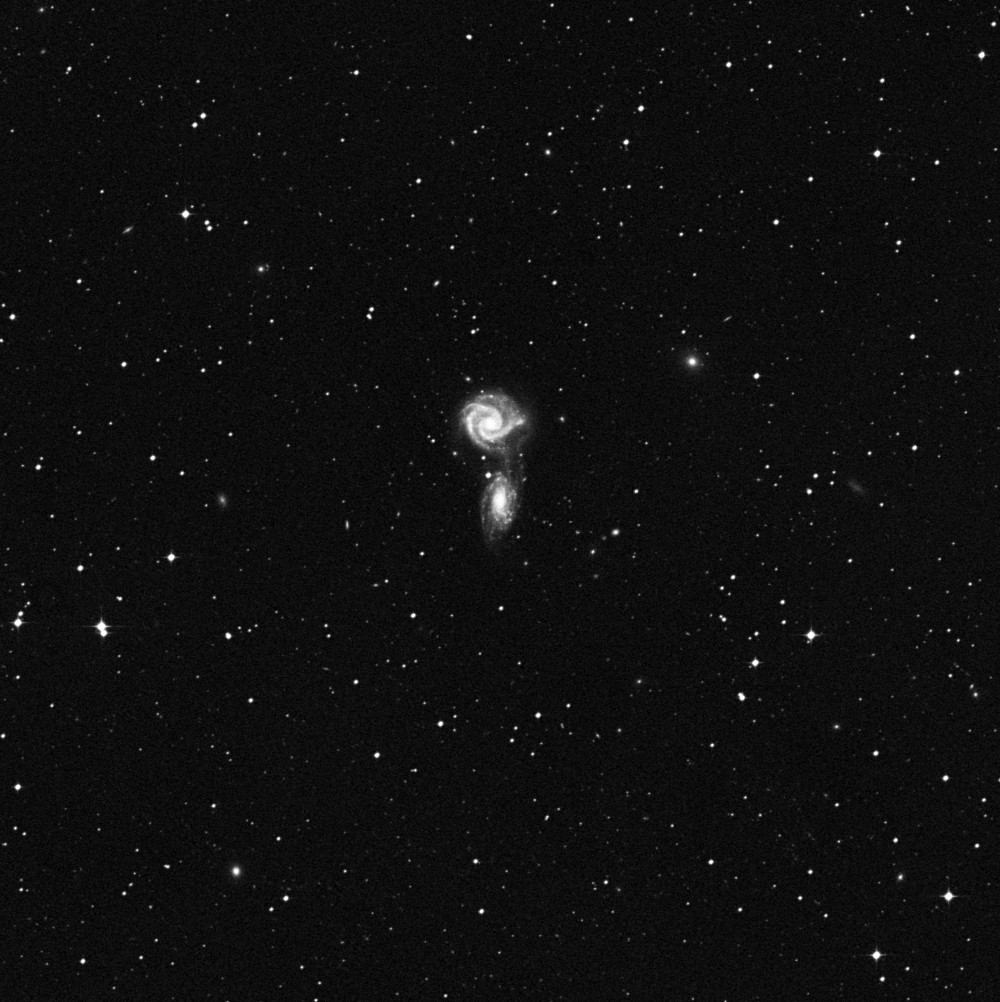
NGC5426 (lower one) & 5427, galaxies in Virgo. The image is 30’ wide.
The Digitized Sky Survey copyright © 1994
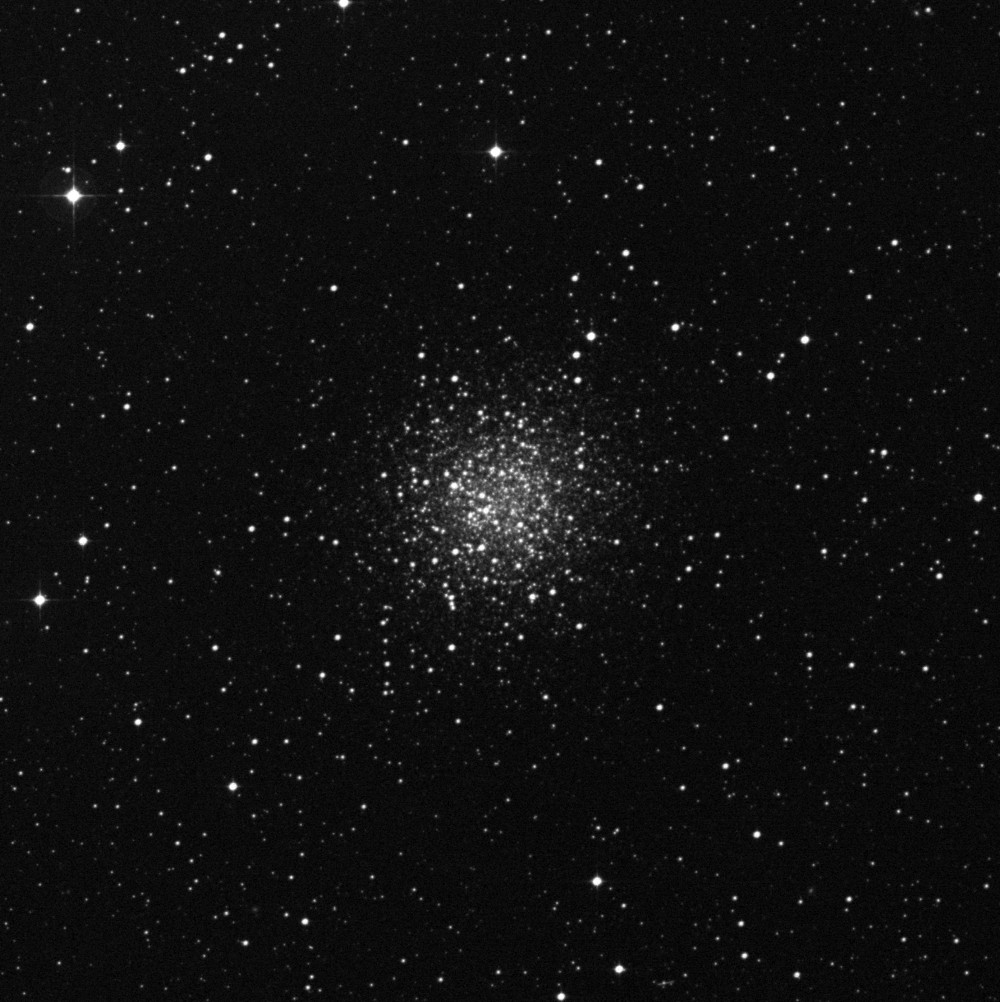
NGC5897, globular cluster in Libra. The image is 30’ wide.
The Digitized Sky Survey copyright © 1994
Comet hunting
It was the fifth comet hunting session in December. Air temperature at the
observing site with an altitude of 940 m above sea level was -5ºC, the
record low in this winter season. However, it was windless and I felt it
rather warm. I began the session from Spica, alpha Virginis. There are a
lot of galaxies upward of the star, the northwest, and I identified four
of them one after another only in three minutes: NGC4941, 4951, 4981 and
4995. After observing those, I encountered NGC5232, a 13-th magnitude
galaxy, in 15 minutes. The galaxy was at an altitude of 31º above the
horizon and was the faintest image for me to be detectable during the
sweep of the sky. Then the following objects came into the FVO including
two globular clusters: NGC5306, 5728, 5716, 5426 & 5427, 5791, 5493,
5897 (globular cluster in Libra), 5506 & 5507 (here, a 22-minute off
for observation of 2I), IC1055, IC998 and NGC5634 (globular cluster in
Virgo). The globular cluster NGC5897 was at 13º above the horizon only,
but it was resolved into stars thanks to the power of NV. During the
twilight before I ended the session Mars and delta Scoprii passed through
in the FOV.
Thursday, November 21
After a week of sick leave, my shoulder got much better and I could drive
my car. This was the fifth comet hunting session in November. I had a plan
to observe at the site A near my residence. Unfortunately, the volcano,
Aso Nakadake, has been active and ash fall was predicted around my house
including the observing site A.
I was forced to go to the site B.
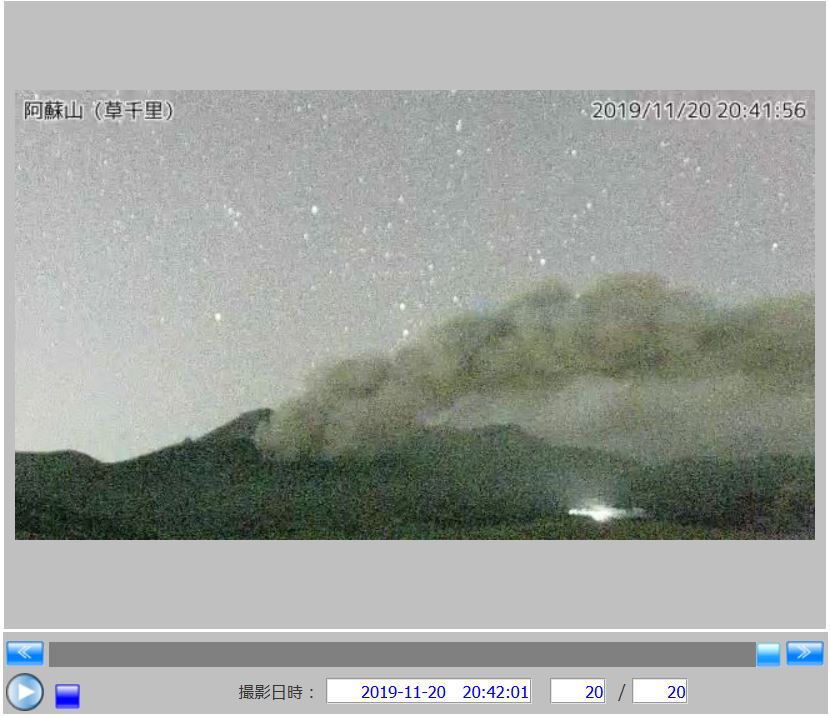
Volcano, Aso Nakadake at night. Volcanic smoke hides the part of Orion.
Image from the volcano watch camera. Nov. 20, 2019. © Japan Meteorology
Agency.
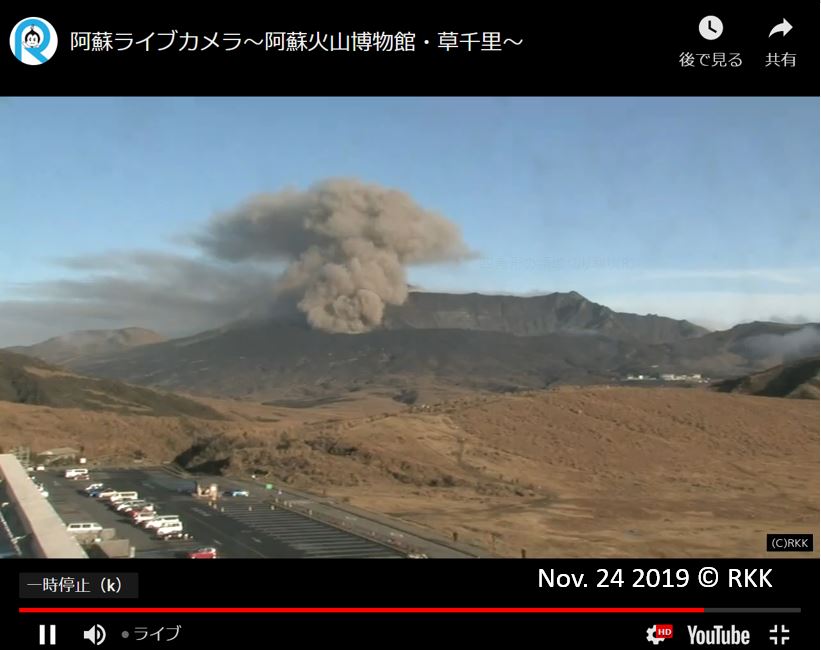
Voclano, Aso Nakadake, on daytime. Nov. 24, 2019. © RKK, Kumamoto
Broadcasting Co., Ltd.
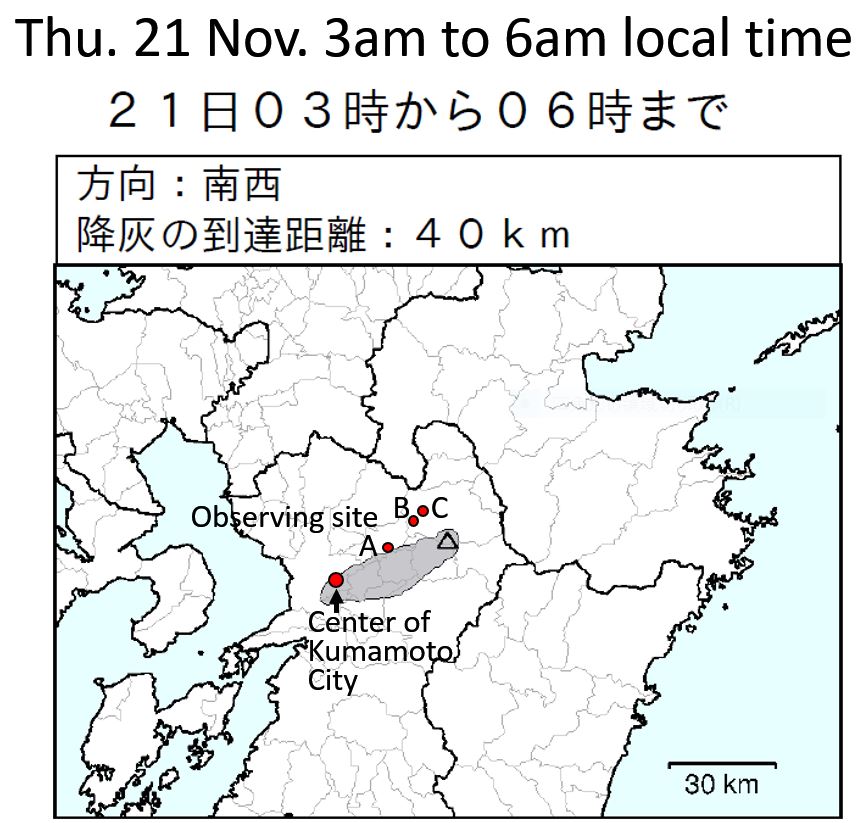
Ash fall prediction by Japan Meteorology Agency at 20:00 Nov. 20, 2019
local time.
It was predicted that volcanic ash reached at the center of Kumamoto City.
It was very cold due to strong wind and low air temperature, 0°C. I
installed my comet seeker at the place where wind gust could be avoided
and I could manage to search the sky. It took longer time than usual to
set up the telescope because of coldness, i.e. slightly less than one
hour. The waning crescent moon was in the constellation of Leo, and I
searched the south of the ecliptic. Specifically, I started with nu
Hydorae.
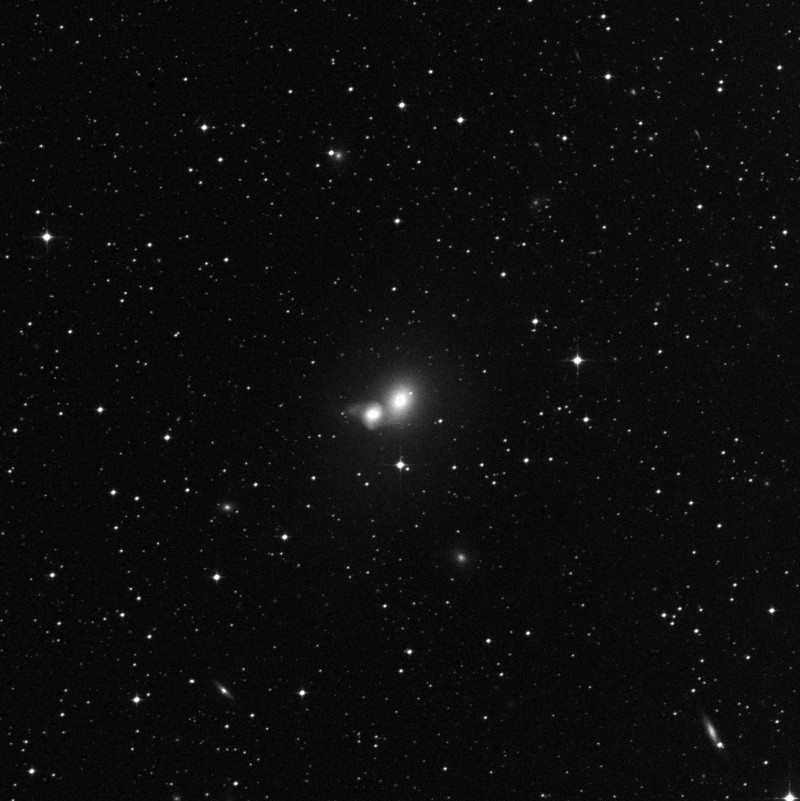
Interactive galaxies NGC4105 and NGC4106. The image is 30’ wide.
The Digitized Sky Survey copyright © 1994
The first galaxy that I identified was NGC3497 (11th magnitude) in the
constellation of Crater. The 13th magnitude galaxy that was expected to be
seen in the same field of view, NGC3529, was not visible due to the
moonlight. A bright galaxy NGC3923, 9th magnitude, was observed at an
altitude of only 13°. Interactive galaxies NGC4105 and NGC4106 were split
easily.
I overlooked NGC3981 (11th magnitude galaxy) but noticed NGC3957 (12th) in
the same FOV. It is probably because the surface brightness of NGC3957 is
higher than that of NGC3981. Then galaxies that I identified were NGC3672,
3887 and 4027. The last object was a pair of galaxies NGC4038 and 4039,
also known as Antennae Galaxies. When epsilon Corvi was came into the FOV
I completed the session.

Volcanic ash on my car. Click the image to
enlarge
On the way home when I drove through a view point at the northern rim of
the crater, I saw volcanic ash moved toward my residence over the central
part of Kumamoto City, as the forecast predicted. The entire town
including my house was lightly covered with ash fall. We have experienced
ash fall for several months. Local people told me that such long lasting
ash fall has not been observed since 1992 to 1993.
Thursday, October 31
I am suffering from a frozen shoulder with a sharp pain since last
weekend, and take sick leave. I still cannot drive a car and conduct a
comet hunting.
This month I searched the sky five times but can not afford to write the
details.
Saturday, September 28
It has been
very nasty weather in August and I could conduct comet hunting session
only once. Unpleasant weather went on this month, too. I had three comet
searching sessions in September, but the sole satisfactory session out of
three, I summarized them all below, was that on Thursday September 19.
Monday, September 19
Beautiful sky for the first time in a month. The sky condition was the
highest in Aso area, because fog at the lower altitude covered light
pollution of the area in addition to excellent transparency of the sky.
Before the start of the comet hunting session I observed four comets that
I have listed at home. The values of their apparent diameters and
magnitudes were determined by intuition. All comets were at high altitude
above the horizon. Only C/2017 T2 had an image that was challenging to
discover if I encountered it during the comet searching session.
260P McNaugut: dia. 1’, mag. 11, tail 0.5' in length, CD=3 at 2:57am local
time
Beautiful
tail was impressive.
C/2018 W2 Africano: dia. 2’, mag. 11, CD=3 at 3:00am local time
C/2018 N2 ASASSN: dia. 1’, mag. 11, CD=5 at 3:03am local time
C/2017 T2 PanSTRRS: dia. 0.5’, mag. 13, CD=3 at 3:10am local time
After observing comets I observed the Horse Head nebula using Night Vision
(NV) with Hα filter. The nebula was wonderful as if I had seen the photo.
I also observed M42 and began searching with Rigel, alpha Orionis.

A pair of NGC2207 and IC2163. The image is 30’ wide.
The Digitized Sky Survey copyright © 1994
I identified some galaxies that I have never observed before thanks to the
combination of the power of NV with excellent sky condition. They were
NGC2196 (the constellation of Lepus, magnitude 10.9, altitude 13˚), a pair
of galaxies NGC2207 and IC2163 with an interesting shape (Canis Major, 11
and 11.7, 13 ˚), PGC18858 (Canis Major, 12.7, 15˚), NGC1924 (Orion, 12.5,
42 ˚) and NGC2110 (Orion, 12.5, 41˚). They were identified at the
altitudes of 15 degrees or less except for the last two objects.
During the session I was interrupted by fog extended from the lower
altitude for 12 minutes. Nonetheless, I had a quality time with one hour
of searching on top of observing some objects that I encountered for the
first time.
Thursday, September 19
I confirmed clear sky in Aso area using the volcano surveillance camera,
and headed for the site.
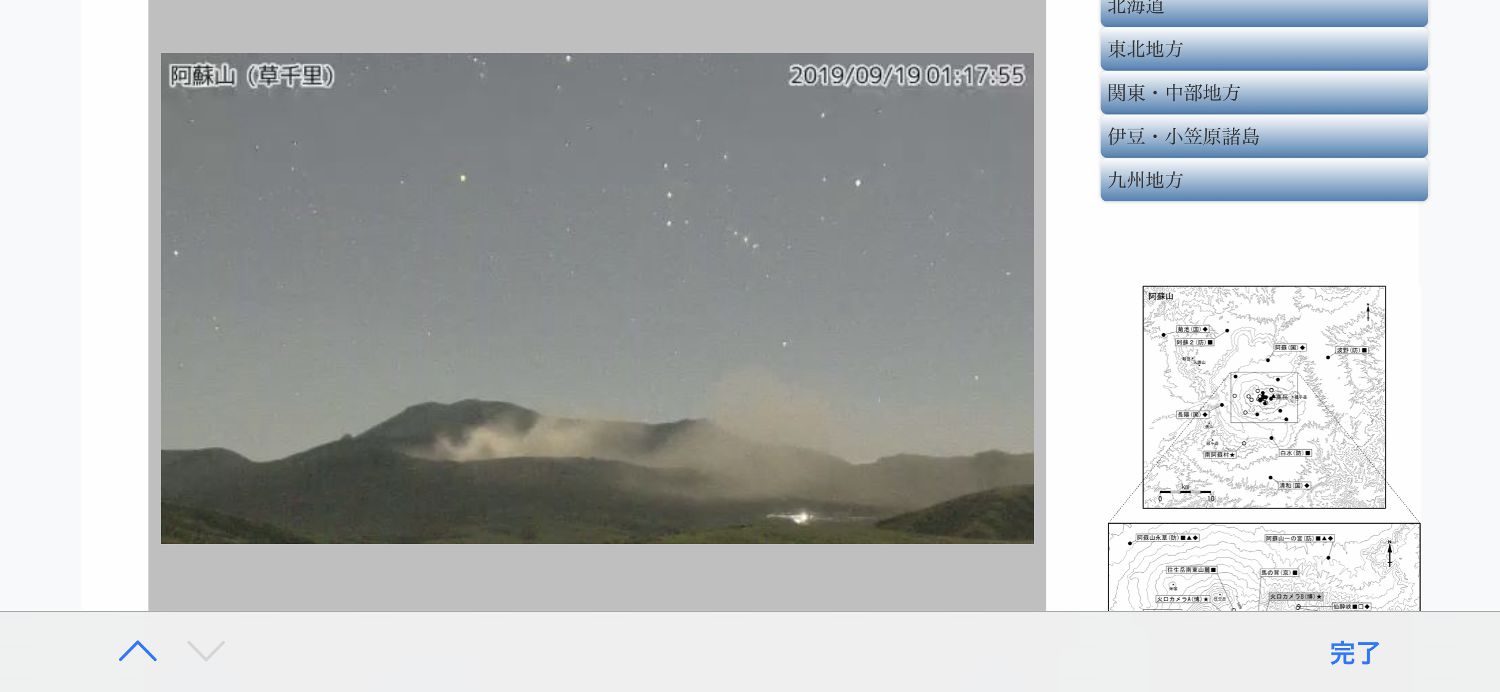
Image of the volcano surveillance camera. Orion rose above the volcano. ©
Japan Meteorology Agency
The condition for observation was poor as the moonlight with moon phase of
19 and strong wind. I set up my comet seeker at the place where exposure
to the wind was avoided. Prior to the comet hunting session I observed
around the constellation of Orion using NV with Hα filter with equal
magnification. The Rosette Nebula floating in the sky was clear, and the
Barnard Loop was visible though it was faint due to the moonlight.
Then, I compared the visibility of the two comets using NV and the glass
eyepiece. For glass eyepiece I applied nonfilter, the light pollution
filter and the comet filter. As shown in the table NV got the higher score
than glass eyepiece for comet observation under the moonlight.

I spent one hour for sweeping the sky, but non comet-like objects (DSOs)
were identified because of the moonlight.
Wednesday, September 25
The forecast predicted it would be cloudy until 4am local time, as a
clumpy of clouds were passing through the northern part of Kyushu Island.
I arrived at the observing site and took a bread watching a waning moon
for a while. Then, I set up my comet seeker and the sky got clear at 4am
as predicted. However, the amount of clouds was not less and the altitude
of 20 degrees or less had been covered with clouds all the time.
I intended to discover the Sun Grazer Comet and started searching with
M50, an open cluster in the constellation of Monoceros. After 20 minutes
the area was covered with clouds and I trained my telescope at the
northeast. I observed NGC2685 and 2950. When M108 came into the FOV clouds
began to hide the area of the sky. I aimed my comet seeker at the cloud
less area, the north. The day has broken without identifying any DSOs.
Saturday, August 3 to Sunday, August 4
Airglow and volcanic ash
Today,
Saturday, August 3, volcanic fuming of Mt. Aso Nakadake looked prominent.
There were a few small eruptions recently, and the volcano was getting
active. I checked the wind direction around the volcano via automated
weather stations and predicted that no volcanic ash fall at the
observing site B. Then I headed to the site.
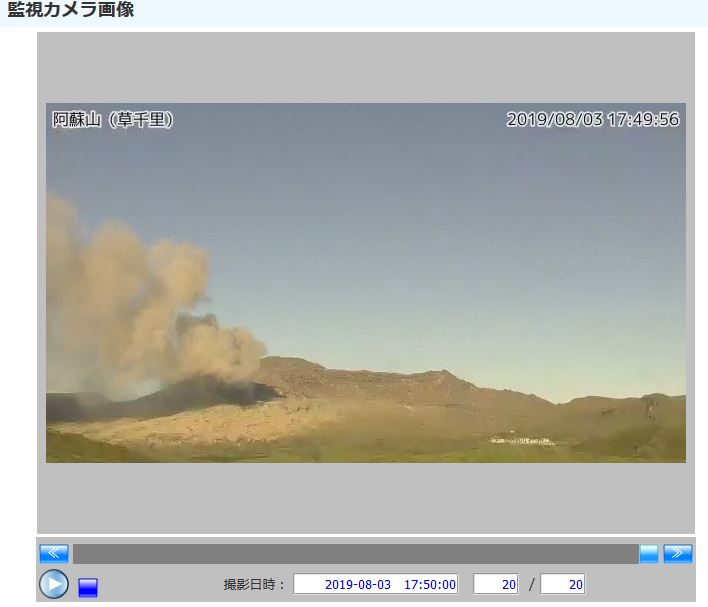
Volcanic fuming of Mt. Aso Nakadake. Live camera of the Japan
Meteorological Agency.
I arrived at the site B at 9p.m. At dusk the western sky was heavily light
polluted by the light of Kumamoto City. I turned on Night Vison (NV) after
a long interval and watched the sky with 1x. M31 at the altitude of 12
degrees above the horizon was very easy target and clear.
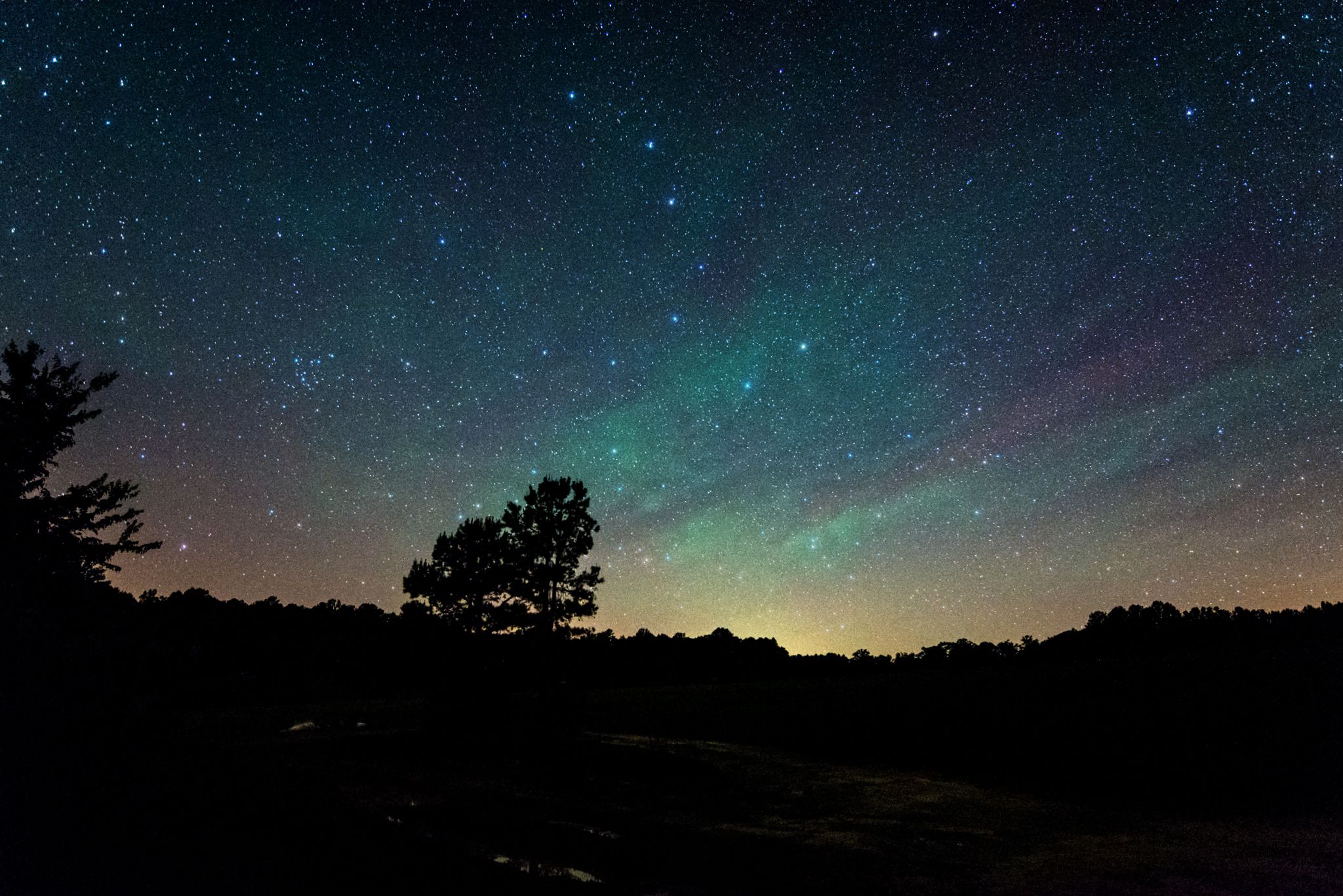
Airglow. Source: https://www.flickr.com/photos/skynoir/14273851604
On top of that I saw something unexpected: airglow or night glow. As shown
in the photo it looked a trailing cloud at the low altitude of the sky. I
have ever seen possible airglow with my 46 cm comet-seeker, but I was not
sure as it was not evident in appearance. Contrarily, this time I was
astonished by the image that was much the same as the photo above.
After I set up my comet-seeker and was about to start the hunting session,
suddenly, thin cloud began to cover the sky. I was forced to give up the
comet hunting and instead enjoyed watching Saturn and Jupiter. I compared
the image of the planets using three magnifications: 291x with Pentax
XW7mm, 339x with the combination of Nagler 12mm and the 2x barlow lense,
and the binoviewer about 300x with the combination of SWA 20mm and the 2x
barlow lense. Preponderantly, the image with the binoviewer was excellent.
The seeing was 6/10 and in my experience under the seeing of 8/10 or
better, single eyepiece works better than the binoviewer.
At 9:41p.m. local time the amount of cloud in the south decreased and I
started comet hunting. I comet searched last on Wednesday, June 25. I
trained my telescope M22 and swept the south, because there remained some
cloud and was light pollution from Kumamoto City in the west. The southern
sky was not satisfactory as there were clouds at the altitude of 20
degrees and lower, but transparency was good. The DSOs I identified were
M70, Palomer 8 (11th magnitude globular cluseter), M54, NGC6723 and
NGC6727with 6729 (the reflection nebulae). All were rather bright objects.
I completed the 40-minute hunting session at 10:22p.m. local time and took
a nap in my car.
Sunday, August 4
It was clear sky with better transparency when I got up at 2a.m. local
time. Prior to the searching session I observed two comets. I compared the
both objects using 97x with Ethos 21mm and 37x with NV (Lavendura 63mm
& Paracorr).
C/2018 W2 Africano 12th mag. 3’, DC 6
C/2018 N2 ASASSN 12th mag. 1’, DC 5
I could not notice the both comets with both Ethos and NV at a glance, and
it was difficult to discover the comets like those. In particular C/2018
N2 with smaller apparent diameter was more challenging to identify.
I spent too much time for observing comets for the first time in a while,
and I swept the sky only one hour. I began the session with Aldebaran,
alpha Tauri. All the DSOs that I observed were only two: Hubble’s variable
nebula (NGC2261) and M1. I encountered NGC2261 at the altitude of only 8
degrees above the horizon, and I took it for a comet for a second as it
looked like a typical comet with the tail.
During the hunting session I stopped sweeping for a while to observe
C/2017 T2 PanSTARRS. The comet was 14th magnitude and perfectly star like
with NV. I could not recognize it with Ethos 21mm.

Remained volcanic ash on the body of my car after drying out of dew.
After a peaceful session I got back home, but I noticed something strange
on daytime when I put my sleeping bag back to the storage. Dew condensed
on my car did not dry out. I thought it doubtful and looked into the body.
Dew dried out completely. What I thought to be dew was volcanic ash that
remained after dew evaporation. The concentration of the ash was too low
to be perceived by my body.
A local amateur astronomer who has lived in Kumamoto for decades of years
predicted fall of volcanic ash and went to the windward observing site. I
still do not know much about Mt. Aso, and only astonished by the activity
of the living volcano.
Monday, July 29
I conducted
no comet hunting session this month. I believed that the hours of comet
hunting increased when I moved to Kumamoto from Tokamachi, Niigata.
Nevertheless, it was wrong. Total hours for comet hunting for around one
year here is almost the same with that in Niigata.
The northern outer rim of the crater in Volcano Aso where the
observing sites B and C are located is often cloudy, though the sky
is clear near my house. The sites are the northeast or the east of my
house, in other words the east of the site A,
and I cannot observe the eastern sky when the northern outer rim of the
crater is in the clouds.
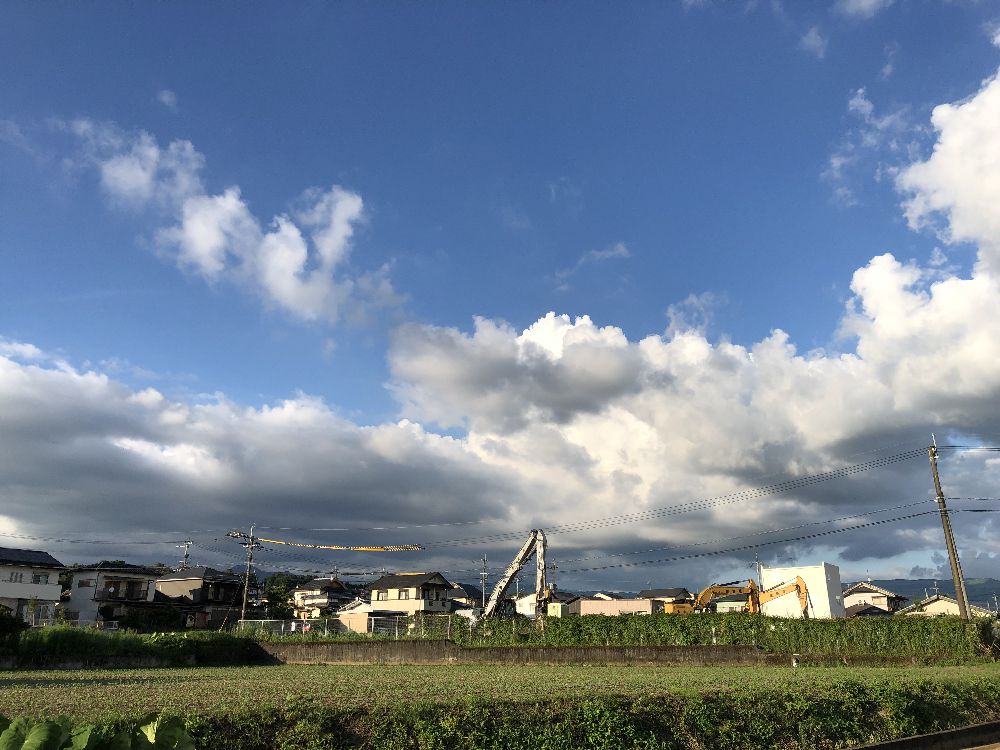
Clouds over the northern outer rim of the crater in Volcano Aso. The photo
was taken from Ozu town where I live. Rain clouds was conspicuous in
contrast to fine weather in Ozu.
Shogo Utsumomiya, the comet hunter living in Minami-oguni, Aso said, “I
think the weather in my town is the most awful in Japan”. I strongly
denied his saying. Now that I have lived here over one year and I feel
what he said is not necessarily wrong.
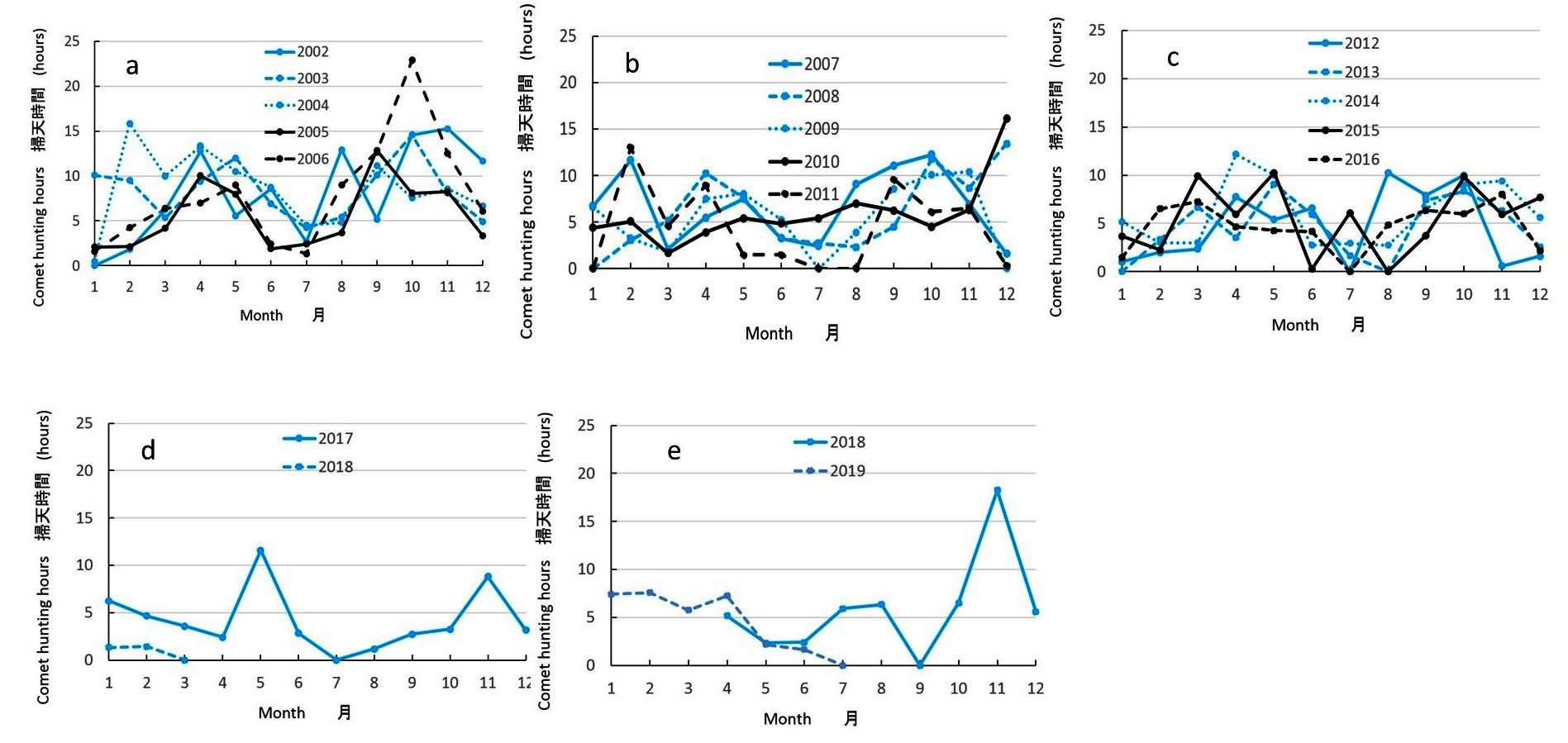
Fig. 1 Monthly hours of comet hunting. (a)―(d) statistic in Tohkamachi,
Niigata, (e) statistic in Ozu, Kumamoto in April 2018 and after. Data in
(a)―(d) include observation other than Tohkamachi, e.g. Nagano, though the
number of days is not a lot.

Fig. 2 Annual statistics of comet hunting. (a) hours, (b) number of times.
Nonetheless, I wonder if the trend of the bad weather is not dependent on
the area but prevails all over Japan or the world. Fig. 1 indicates
monthly hours of comet hunting 2002 to June 2019, and Fig. 2 shows annual
total hours and the number of times of comet searching from 2002 to 2018.
As time goes the total hours decline in all seasons in Tokamachi, Niigata
(Fig. 1a, b and c). In the same way Fig. 2 reveals that both annual hours
and the number of times decrease with time. I spent around 100 hours per
year in 2004 and earlier, but 50 to 60 hours per year in recent years. I
myself did not notice such a drop until I made a statistical analysis. The
cause of the decline in hours is not due to my laziness by aging, but
increase in bad weather.
Seasoned observers like Koichi Itagaki and Shigehisa Fujikawa were
depressed by the recent decrease in the days of observation due to growing
amount of clouds and haze.
I doubt that the satellite data on clouds can prove the trend. Satellite
may not detect thin clouds that are harmful for comet hunting; they makes
it impossible to conduct a comet hunting session and decline the days of
observation, but are too faint to recognize based on my experience.
I think the bad weather is originated by the increase in aerosol and/or
clouds by declining solar magnetic field via the Svensmark solar effect or
anthropogenic activities. It is a serious situation, but it is a natural
phenomenon (maybe in combine with anthropogenic one) and we have no choice
for it but to obey.
Saturday, June 29
It is rainy
season in Japan, and it is natural that we have been cloudy and rainy
weather in June. I summarized comet hunting activity of this month.
Wednesday, June 12: I
headed for the observing site C where it takes
30-minute by car, because the sky was clear. At 2:29am local time, I
started comet hunting with Alpheratz, Alpha Andromedae. Strangely, the
contrast in the FOV reduced in seven minutes and I looked up the sky and
found that thin cloud began to cover the sky rapidly. The next moment it
spread all over the sky.
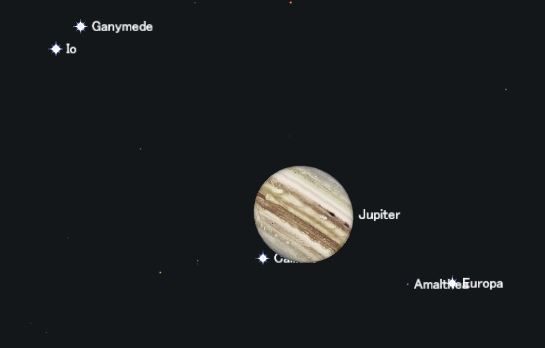
Jupiter IV Callisto is in the vicinity of the south of Jupiter, i.e. lower
left of Jupiter.
Stella Navigator 10/AstroArts
I gave up comet hunting and waited to recover. I enjoyed watching Jupiter.
Callisto that was in the vicinity of south of Jupiter was impressive. I
resumed the session at 2:57am with M31, since there appeared some gaps of
clouds, but I was clouded out again in nine minutes. I stayed the site for
a while but there was no prospective for the recovery. I took down my
comet-seeker just after the start of the twilight. As a result I searched
only 16 minutes.
Sunday, June 23: The sky
was clear and I drove to the site C, though the
waning gibbous moon was on the sky at predawn. At around the altitude of
900 m fog appeared on the road. At the site it was foggy also, and I
decided to get back to the site A near my house. I wasted about one hour
for the round trip.
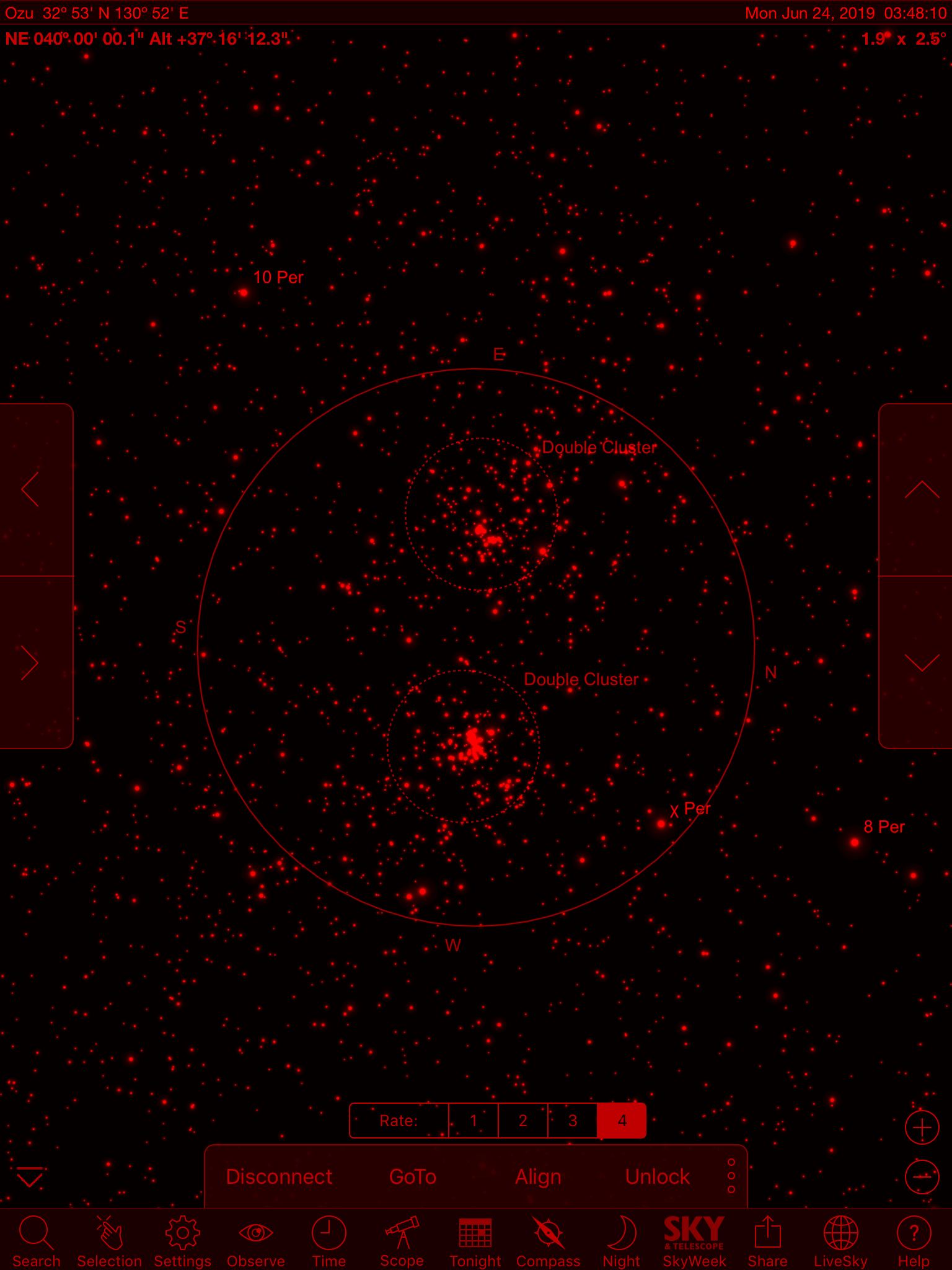
Screenshot of the Double cluster, h-χ, in Perseus taken at the site. The
sky map, SkySafari Pro 6, was synchronized with the telescope.
June 23, 2019, 03:48:10 JST
At the site C I trained my telescope at NGC891, a galaxy in Andromeda,
where I began the hunting session. I thought that even if I used Night
Vison Device (NVD) I could not observe the galaxy under the last quarter
moon, but unexpectedly, I recognized elongated shape of the galaxy.
Nonetheless, I did not see the dark lane. I assumed that I would not
notice this object if I applied usual glass eyepiece. I identified no DSOs
except for NGC891 due to the moonlight. However, I enjoyed star field with
NVD, especially, the Double Cluster, h-χ, in Perseus, was wonderful. I
took a screenshot of the cluster on the digital map, SkySafari Pro 6,
shown on the display of the iPod mini2. Comparing with a decade ago, it is
revolutionary to record what you see in the FOV in a moment, even if it is
not a real image but that of digital map.
Tuesday, June 25: It was
fine at my house, but thin cloud covered the sky above Mt. Aso (probably
the situation seemed to be the same at the sites B
and C). I saw it through the volcano watch camera installed at
Kusasenri-ga-hama (some 1140 m above sea level). It keeps watching Aso
Nakadake, the active crater with volcanic smoke. Actually, at predawn on
Sunday June 23 I confirmed that Mt. Aso area was fine through the camera
and left home for the observing site C. The truth was that, however, the
sites was foggy because the altitudes at sites B and C (930 to 940 m) was
lower than at the camera site.
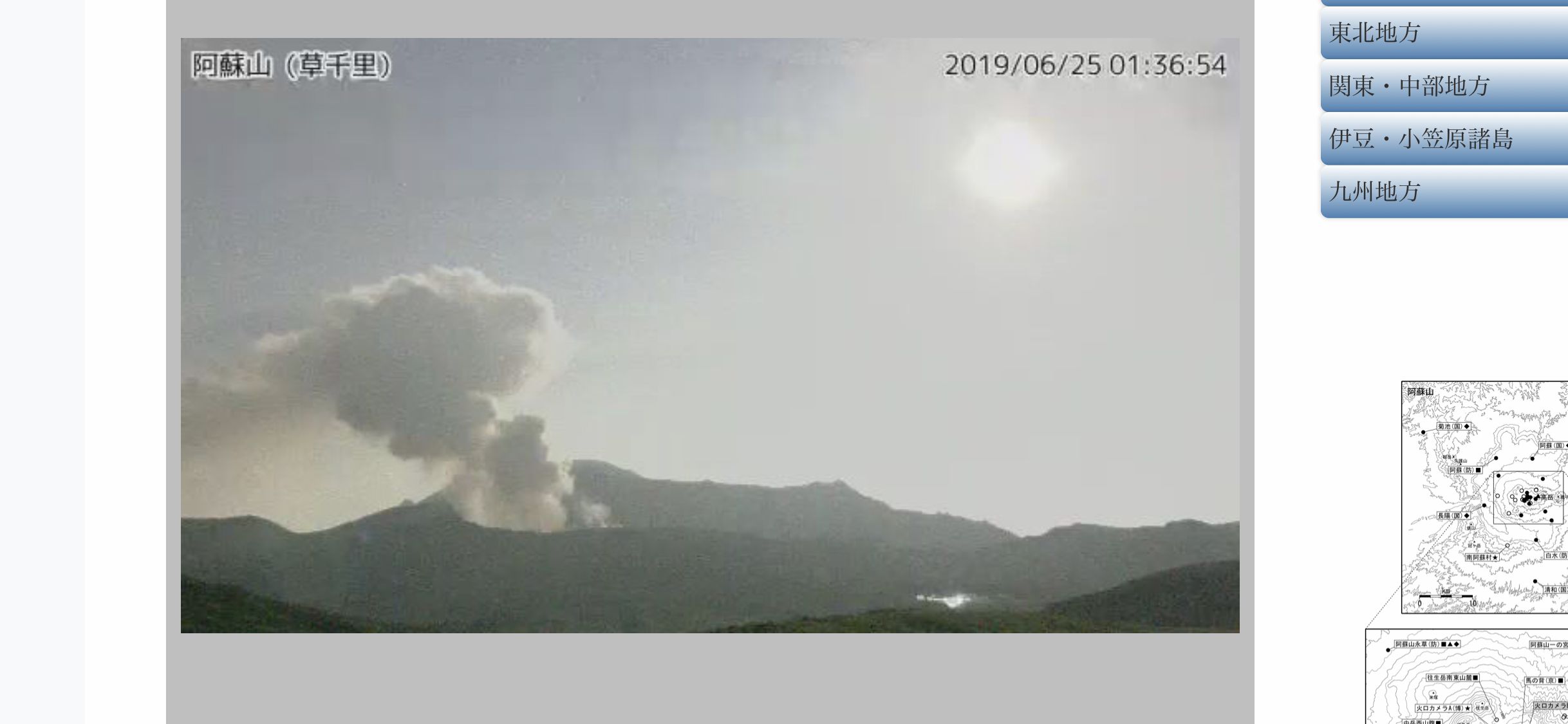
Screenshot of the volcano watch camera for Aso Nakadake. Moon is on the
upper right.
01:56:34 JST on Tuesday, June 25, 2019. © Japan Meteorological Agency
Anyway, I decided to comet search at the site A
near my house as the other sites were cloudy. At 2:29am I began comet
hunting with M76 under the moonlight of the last quarter moon.
Unfortunately, 14 minutes after the start of the session clouds covered
the sky. As an alternative plan I observed Saturn and Moon through thin
clouds. Jupiter was already low at the southeast and not suitable for
observing. Seeing was not bad and the image of the objects was tolerant to
a magnification as high as x500 using Radian 4 mm eyepiece. Thank goodness
to today’s cloudy weather, because it gave me enough time to observe
Saturn and Moon for the first time in a while.
I am sure I have perfect clear sky in a several weeks.
Friday, May 3 to Saturday, May 4
Now it is
what we Japanese call “Golden Week”, i.e. a period of consecutive bank
holidays, from April 27 to May 6. However, it has been rainy and cloudy
for the first half of the period, and finally, we had clear sky at Friday
night. My wife and I went to one of the best observing sites in Japan,
Gokase Highland Ski Resort (32.576329N, 131.121838E, 1300 m above sea
level) for stargazing and comet hunting.
At 5a.m. local time on Friday, May 4, my wife and I arrived at the resort
and checked where to park and set my telescope at night. As predicted by
the forecast a cumulonimbus developed. We once left the ski resort for an
inn because my wife wanted to stay an accommodation.
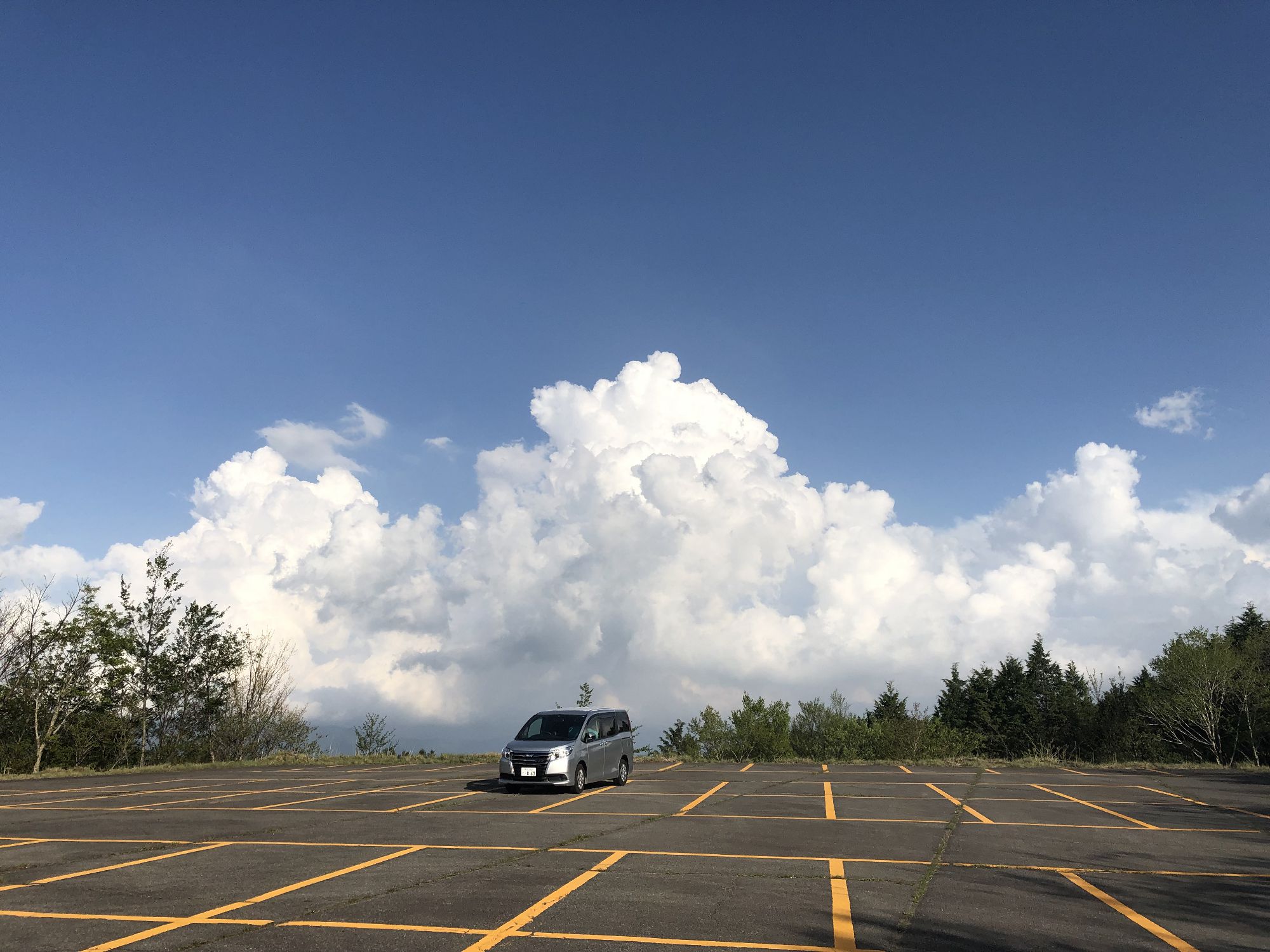
Parking of the
Gokase Highland Ski Resort
Before supper while we were in the inn, there was a thunderstorm but the
sky got fine at 8p.m. when we left for the ski resosrt as predicted by the
forecast.
We saw four vehicles at the parking of the ski resort, and each astronomer
set up the telescope. The strongest light pollution was in the
north-northeast originated from Oita City followed by north-northwest from
Kumamoto City. Light pollution was not serious in the other directions and
rather dark. I observed many DSOs using my 46 cm telescope and I had an
impression that the sky condition was almost the same with that of the
outer rim of the crater in Mt. Aso, i.e. observing
site B and C.
On the ability of Night Vison Device
My wife always said she could not see the spiral structure of M51 with a
glass eyepiece. This time again she could not see the structure, though it
was easily visible for me with a direct vison. Using Night Vision Device
she finally recognized the spiral structure for the first time. She said
the dark lane in NGC4565 was beautiful with Night Vison Device.
Globular clusters and Beehive Cluster were impressive with Night Vision
Device that must be popular with various people.
At around 10a.m. the sky got darker and in my impression the sky condition
was better than that at the outer rim of the crater. At 10:30p.m. I drove
to our inn and dropped my wife. I returned to the observing site and had a
sleep in my car.
On Saturday before 2a.m. local time I got up and set 15x110 mm Russian
binocular in addition to y 46 cm Dob. I observed some DSOs until 3a.m. and
the sky at this time of the night was splendid that was higher quality
than that at observing site B and C,
the outer rim of the crater in Mt. Aso. If you left click the mouth over the Light
Pollution Map and the SQM value with the Bortle scale class appear. Gokase Highland Ski
Resort is categorized as he Bortle scale class 2. One can experience the
sky corresponding to the class 2 at predawn. On top of that the site was
very dry and there was no dew condensation on the telescope and the
vehicle.
At the site I spoke one of the astronomers who was nearby and he said he
came from Saga Prefecture. He drove to the site without using a highway to
avoid the traffic jam that took three and half hours. He said this site is
always dry and the sky condition is the best at predawn as I experienced.
I conducted a comet hunting session for more than one hour from about one
hour before the start of the twilight. I began with M2 and I identified
M15. At the beginning of the twilight I swept near the horizon using
15x110 mm binocular for some 10 minutes and identified M31. After that I
switched to my 46 cm and I observed NGC7438, 13th magnitude galaxy that
was at an altitude of 21 degrees.

Daybreak at the site when I took down my 46 cm telescope.
I took down the materials under a beautiful sky at daybreak. I got back to
the inn, had a sleep and breakfast and left for home.
Saturday, April 13
This is the fourth comet hunting session this month. On my way to the observing site C, I found wind
got strong and changed the destination to the site B where I could
somewhat shelter from the strong wind. At 3:10a.m. local time I began with
M2, the globular cluster in the constellation of Aquarius. I started with
the cluster because I finished the session around it last time, i.e.
Sunday, April 7.
Though I could somewhat avoid the wind at site B, I was not able to
concentrate on the hunting and it was inefficient. The wind was strong
enough to irritate me. During the hunting session I pull down my telescope
slowly peering the FOV from an altitude of some 40 degrees to the horizon.
Once the telescope reaches the horizon I move the telescope about 0.5
degrees northward, and leave my eye from the eyepiece. Then, I push up the
optical tube assembly up to some 40 degrees in altitude above the horizon
at once, and again I pull down the telescope gently toward the horizon
looking into the eyepiece. I repeat the process many times. However, under
the windy condition it is difficult to move the telescope at a constant
speed that irritate me. The Dobsonian telescope is weak for strong wind
because it has large cross sectional area for wind. To mitigate the week
point I rolled up the light shroud to the upper end of the optical tube
assembly to reduce the cross sectional area.
In the area between the constellation of Sagitta and Aquila at an altitude
of around 40 degrees the FOV was full of stars in the delicate stream of
the Milky Way. The view was spectacular; Night Vision Device made it
possible to see more stars in the FOV in comparison with using a usual
glass eyepiece. Soon after that M71, a globular cluster in Sagitta, a
fresh group of stars that was like a popping firework came into the FOV.
The next object I encountered was NGC7006, 10th magnitude globular cluster
in Delphinus that resembles a comet with high degree of concentration. I
increased the gain of Night Vision Device but the cluster did not resolve.
One of the advantages of Night Vision is that multiple stars that are
nearly limiting magnitude of the telescope gather to form a nebular-like
object, Tsutomu Seki called it as “a shimmer object”, are resolved into
individual star by increasing the gain. In case of a glass eyepiece, what
the observer can do is either peering at the object patiently until the
moment when seeing is stable and the stars are resolved or using a higher
magnification by changing the eyepiece. Today, alternatively, we can refer
a digital map that includes dark stars, e.g. 15th magnitude, but Night
Vision makes it in a very simple way: turning a nob and increase the gain.
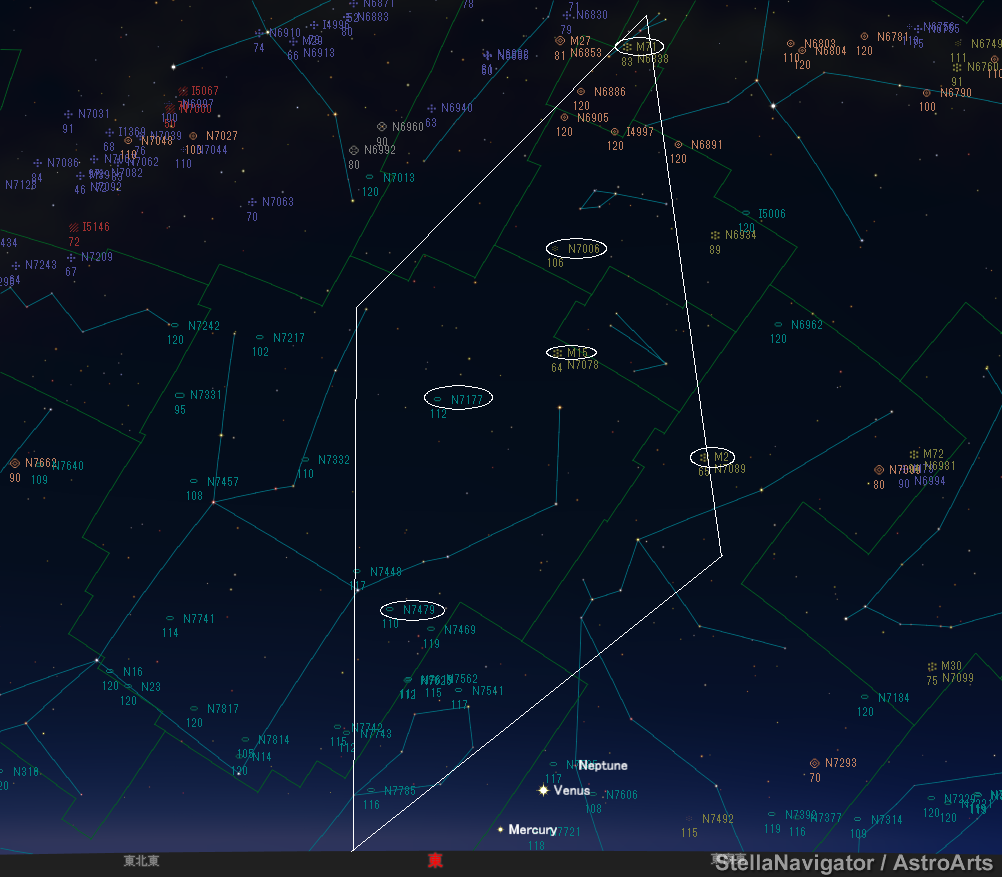
Quadrangle: the area I swept on Saturday, April 13, 2019
Oval lines: DSOs that I observed with the number and magnitude.
The next DSO that I came across was M15, a globular cluster in Pegasus.
The cluster resolved into so many stars and impressive. At 4a.m. local
time the strong wind was settled and I could concentrate on the session.
At 4:24a.m. the time just when the beginning of the twilight I identified
NGC7177, 11th magnitude galaxy in Pegasus, and at 4:34a.m. I did NGC7479,
a galaxy with the same magnitude in the same constellation at an altitude
of 14 degrees above the horizon. Those are the DSOs that I observed today.
As shown in the figure I swept some 30 degrees azimuthally and some 40
degrees altitudinally. The figure indicates DSOs 12 magnitude or brighter.
Among those I overlooked planetary nebulas with small apparent diameters
in the constellations of Delphinus and Sagitta and galaxies at a low
altitude in Pisces and Pegasus. The results implies the limitation of
visual comet hunting. If I had not employed Night Vision Device, I would
have overlooked at least NGC7479.
Sunday, March 24
I comet hunted seven times in March so far, but among those it
was only once that I was satisfied with the sky condition.
Recently, I conduct a comet hunting session at one of the three
observing sites: the site A, B or C that are shown in the figure below.
The site A (150 m above sea level) is in Ozu Town where I live and it
takes five minutes from my house by car. Both the site B and C are on
the outer rim of the crater of Mt. Aso with an altitude of 930 m and 940
m above sea level, respectively. The site B is 25 minutes’ drive and the
site C is 30 minutes. The total condition of the sky, i.e. the view and
the degree of light pollution, becomes better in the order of A, B and
C. If time permits, I want to observe at the site C.
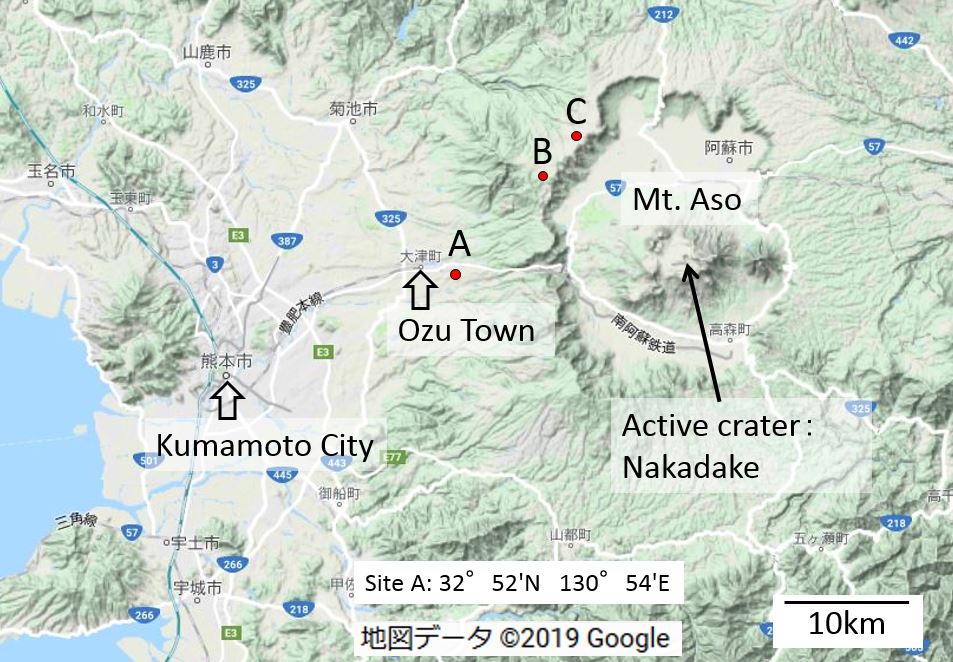
The situation of the seven comet hunting sessions this month is as
follows.
Friday, March 1
I went to the nearest site, A, because fine weather was not expected. I
wound up the session in 20 minutes because the air transparency was poor
with thin cloud.
Tuesday, March 5
I arrived at the site C but fog veiled the sky at the altitude of 20
degrees or lower. On top of that the transparency of the entire sky was
poor. I started sweeping the sky with M8 and spent one hour and five
minutes. M22 was splendid through Night
Vision Device, however, the session was not satisfactory as a
whole due to amplified light pollution by haze.
Friday, March 8
The sky was clear at my house. On my way to the site C at the altitude
of 800 m wind got strong. To avoid strong wind I headed for the
observing site B instead of the site C. At the site B one can somewhat
avoid the wind thanks to the complex topography. Though at the site B
the sky was clear perfectly at 3:15a.m. local time, clouds increased
while I was setting up my comet seeker and I was clouded out before I
began to the hunting session. After an hour of waiting finally it got
fine, but the lower part of the sky was covered with fog and at the site
I found myself to be in damp haze. The air temperature was -3 degrees
Celsius. I began the session with M27 and spent one hour and forty
minutes, but I must say the sky condition was rather poor.
Wednesday, March 13
I could not measure the sky condition properly at my house, but anyway,
it was cloudless and I headed for the observing site A. There existed
clouds at the low altitude of the sky and thin clouds covered near the
zenith. I decided to get back to home without sweeping the sky.
Thursday, March 14
At 4:25a.m. local time I started the comet hunting session with M11 at
the site A. The air transparency was very bad, probably due to cedar
pollen. Five minutes after identifying M72, i.e. 5:30 a.m. local time, I
finished the session.
Friday, March 15
It has been poor sky condition even if it was cloudless such as poor
transparency, thin clouds and haze. I have been disappointed and did not
expect clear sky on my way to the site A. Unexpectedly, however,
transparency was good and I was pleased with the session. Also, I was
regret that I would have been at the observing site C on the outer rim
of the crater. During the session I identified the globular cluster
IC1276 in Serpens probably for the first time. Though the cluster is
10th magnitude, it is challenging to spot due to the faintness. That
proved the power of Night
Visio Device.
The following day an astronomy companion sent me wonderful photos of the
center of Scorpius that were taken at the site C. If I had been there, I
could have met him.
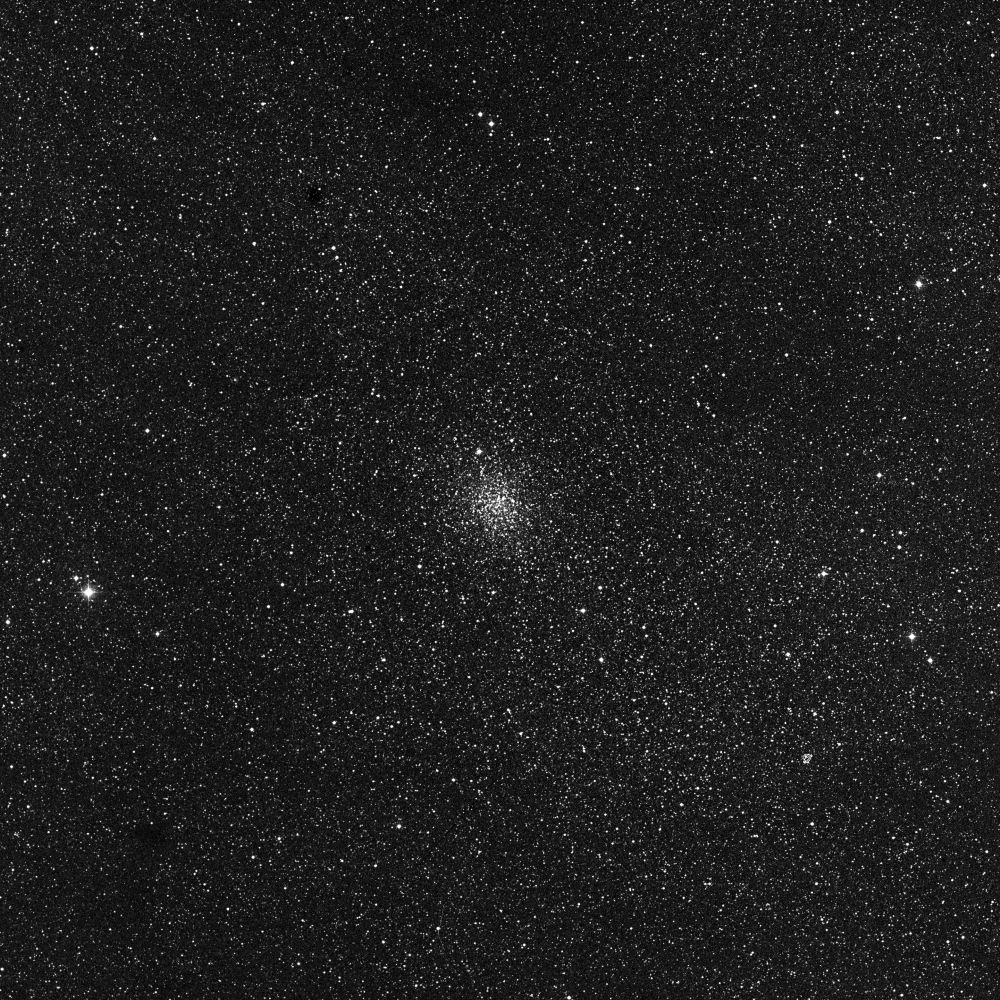
IC1276, a globular cluster in Serpens. The image is 60' wide.
The Digitized Sky Survey copyright © 1994
Sunday, March 17
At 2:20a.m. I saw that the sky was clear in front of my house. Wind was
getting strong on my way to the site C, and I changed the destination; I
headed for the site B instead of C. At the site B wind was also strong
and cloudy. I have waited for the recovery for half an hour but there
was no prospect. I drove back to the observing site A near my house, and
found myself that the sky was clear. It is true that in many cases the
weather in the outer rim of the crater, the sites B and C, is worse than
at A because of mountainous terrain.
At 4:30a.m. I completed setting up my comet seeker, but suddenly it got
cloudy. I could not introduce the alignment stars of the digital setting
circles. Finally, at 4:45a.m. I could manage to align through the gaps
of clouds and searched in the gaps that existed here and there.
Nonetheless, there were thin clouds in the gaps that prevent me from
concentrating on the searching. I ended the session in 30 minutes.
Almost one year has passed since I moved to Kumamoto. Though I thought
to build an observatory at the site B or C, it is sure that the weather
of those two sites is much worse than at site A. Considering the fact it
seems that the mobile observation style is better than building the
observatory.
Monday, February 18
I comet hunted five times after Jan 20th. Besides those sessions I went
to the observing site three times, but I was forced to get back home
because of being clouded out and so on after setting up my comet-seeker.
I also cannot help stopping the comet hunting session due to strong
wind. The weather had been unstable for a month because of cold wave.
The instruments that I employed for comet searching consisted of 46 cm
reflector, Lavendura 63 mm eyepiece and Paracorr that produce x37 with Night Vision
Device, PVS-14.
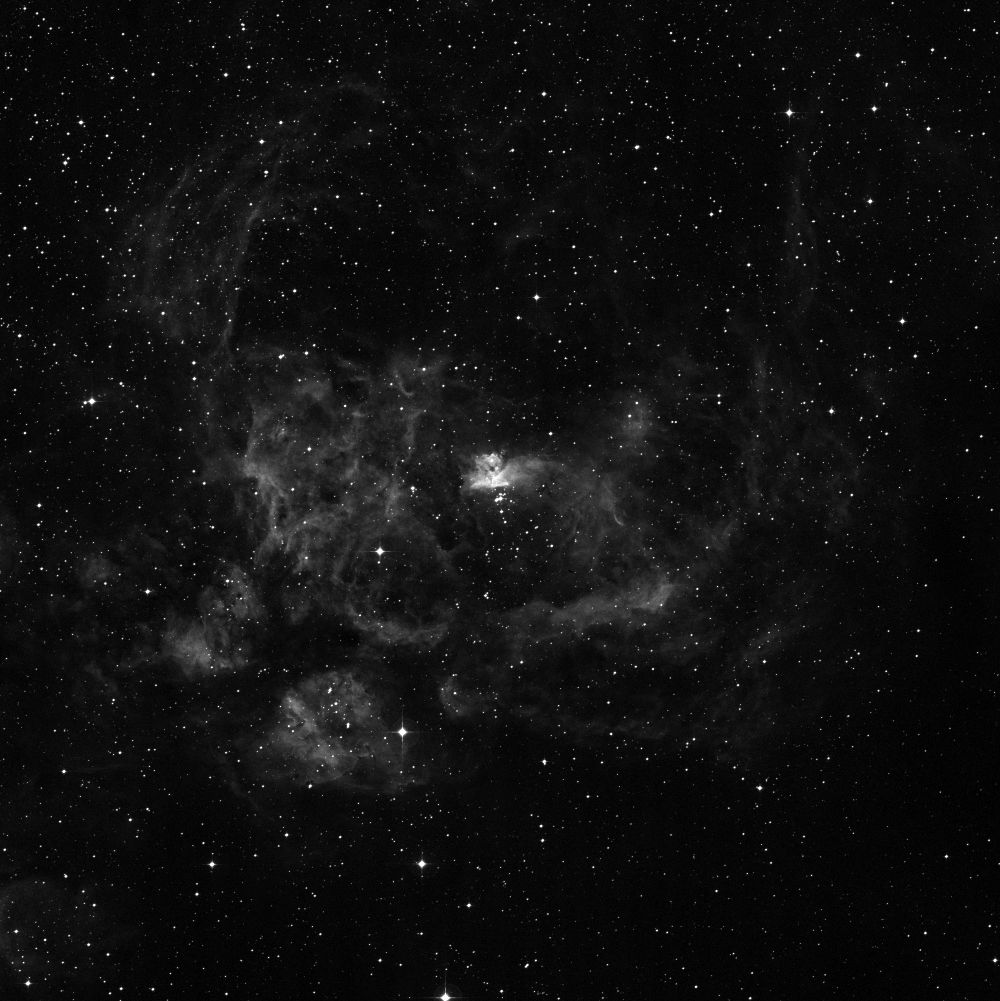
NGC6357. The image is 60’ wide.
The Digitized Sky Survey copyright © 1994
On Sunday, Feb. 10th JST I identified NGC6357, also known as Lobster
Nebula, in Scorpius for the first time during the hunting session, which
I have never encountered during the searching session using a glass
eyepiece. I remembered that I have ever observed the nebula since it is
visible with a glass eyepiece applying OIII filter. However, I saw the
center of the nebula without a filter using NVD.
Besides the comet hunting activity I investigated the visibility of
comets by changing filters. I also looked into the difference of
visibility between NVD and Ethos 21 mm x97. I report the part of the
results.
In the report below, I referred to HOYA V30 filter that I purchased,
because I thought it to be effective for comets based on the spectral
output of the white
phosphor (P45 in the figure).
Sunday, Jan 27
I compared the visibility of three comets under the moonlight of the
last quarter moon. I observed the comets using Ethos 21 mm without
filter and with three filters: HOYA V30, IDAS LPS-P2, Lumicon Comet
(Table 2). Among three comets, 38P and 46P looked brighter for all three
filters, but I could not evaluate C/2018 Y1 due to moonlight, i.e.
invisible or not certain.
As shown in Table 2 all filters had an adverse effect for NVD.
Nevertheless, NVD got two points higher (0.4 magnitude brighter by
intuition) for the comparison between Ethos 21 mm and NVD without
filters that is not shown in the table.
|
Table 1 表1
|
Jan. 27 Last quarter moon 下
弦の月
|
|
The score of the comet brightness without filter is
10, and added 1 point as it becomes 0.2 magnitude brighter. The brightness was determined by
intuition.
フィルターなしの明るさを10として、0.2等
増すごとに1点加点している。明るさは直感で決めた。
|
|
Ethos 21 mm, x97 without NVD ナ
イトビジョンなし
|
|
Comet
|
C/2018 Y1
|
38P
|
46P
|
|
Iwamoto
|
Stephan-Oterma
|
Wirtanen
|
|
Filter
|
|
|
|
|
None
|
Invisible 見えず
|
10
|
10
|
|
HOYA V30
|
*
|
12
|
11
|
|
IDAS LPS-P2
|
Invisible 見えず
|
12
|
13
|
|
Lumicon Comet
|
*
|
12
|
13
|
|
* I observed extremely faint image, but not certain
if it was the comet.
|
|
* 極
端に淡いイメージが見えたが、彗星かどうかの確信が持てない。
|
|
|
|
|
|
Table 2 表2
|
Jan. 27 Last quarter moon 下
弦の月
|
|
Lavendura 63 mm, x37 with NVD
ナイトビジョン使用
|
|
Comet
|
C/2018 Y1
|
38P
|
46P
|
|
Iwamoto
|
Stephan-Oterma
|
Wirtanen
|
|
Filter
|
|
|
|
|
None
|
Invisible 見えず
|
10
|
10
|
|
HOYA V30
|
Invisible 見えず
|
8
|
8
|
|
IDAS LPS-P2
|
Invisible 見えず
|
Invisible 見えず
|
8
|
|
Lumicon Comet
|
Invisible 見えず
|
Invisible 見えず
|
5
|
Saturday, Feb 2
I evaluated the effect of filters for C/2018 Y1 only at the moonless
night (Table 3 and 4). For Ethos 21 mm HOYA V30 showed counter effect,
IDAS LPS-P2 did no effect and Lumicon Comet functioned well. For NVD
Lumicon Comet had the opposite effect but the others worked well.
|
Table 3 表3
|
Feb. 2 Moonless night 暗
夜
|
|
Ethos 21 mm, x37 without NVD
ナイトビジョンなし
|
|
Comet
|
C/2018 Y1
|
|
|
Iwamoto
|
|
|
Filter
|
|
|
|
None
|
10
|
|
|
HOYA V30
|
6
|
|
|
IDAS LPS-P2
|
10
|
|
|
Lumicon Comet
|
12
|
|
|
|
|
|
Table 4 表4
|
Feb. 2 Moonless night 暗
夜
|
|
Lavendura 63 mm, x37 with NVD
ナイトビジョン使用
|
|
Comet
|
C/2018 Y1
|
|
|
Iwamoto
|
|
|
Filter
|
|
|
|
None
|
10
|
|
|
HOYA V30
|
12
|
|
|
IDAS LPS-P2
|
13
|
|
|
Lumicon Comet
|
6
|
|
Empirically, some comets looked brighter with NVD than with
Ethos 21 mm and vice versa. The effect of filters differs depending on
the comets and the sky conditions (Tables 1 to 4).
Thus, it turned out that some comets can be discoverable with NVD but
not with the glass eyepiece and vice versa. As a result, so far there is
no clear conclusion on the effectiveness of NVD and the application of
filters for comet hunting.
What is certain is that NVD shows its power under the condition of thin
cloud, haze and light pollution and that globular clusters look as if
they were observed using a telescope at least twice as large as the
actual one. No one knows what happens with the use of the apparatus. I
make a big bet.
Saturday, January 19
On C/2018 Y1 Iwamoto observed by Night
Vision Device
The day when I updated this article last month, Dec. 19 2019 JST,
C/2018 Y1 Iwamoto was discovered. At that time I was sweeping the north of
Venus while the comet was found on the south. The day before discovery an
acquaintance of mine took a photo of the positon with the limiting
magnitude of around 13th. However, the comet was not confirmed. I think
the comet got bright on the day of discovery. Finally, I could observed
the comet on January 3rd.
C/2018 Y1 was bright with a magnification of 97 using Ethos 21 mm.
Nonetheless, it was difficult to observe with Night
Vison (NV), and it was impossible to spot the image during the
hunting session. The combination of NV and a light pollution filter, IDAS
LPS-P2, highly improved the comet image as bright as that seen with Ethos
21 mm. I have ever observed seven comets using my 46 cm with NV, but NV
had opposite effect only for C/2018 Y1 in comparison with a glass
eyepiece, e.g. Ethos 21 mm, without NV.
Without doubt C/2018 Y1 is a gas-rich comet. However, some gas-rich comets
looked bright with NV. The combination of NV and IDAS LPS-P2 is not
necessarily effective for all comets, i.e. I have confirmed it showed
counter effect for some comets. NV can have negative effect for comet
hunting.
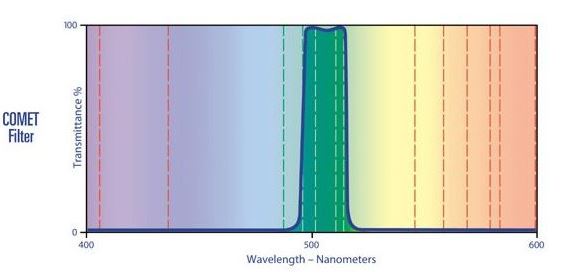
Transmittance of Lumicon Swan Band Comet filter
I heard a story that Howard Brewington discovered a new comet visually
using Lumicon Swan Band Comet filter in Boston where heavily light
polluted. I also have the filter, but I confirmed that the filter has
counter effect for some dust-rich comets. The combination of this filter
with NV does not work at all. I must say no tools are perfect.
Observation and comet hunting session on Jan. 19 JST
This was the seventh comet hunting session in 2019. Prior to the session I
observed M101. First of all, I used a magnification of 97 with Ethos 21
mm. I recognized several spiral arms that were more obvious with averted
vison. Then, I used NV with a magnification of 37, and the image was
similar but the arms could be seen without averted vison. I must say NV
gave a better view of M101.
The next target was Omega Centauri. The altitude of the cluster was only 8
degrees above the horizon, but it was wonderful and I gave a shout of
surprise. The dissolved stars were filled with FOV. In the literature the
apparent diameter of Omega Centauri is 23’ but stars are spread with high
density outside of 23’ from the center that looks the cluster nearly 1
degree in diameter, while the actual FOV is 1.1 degrees.
It was only 51 minutes from the moonset to the beginning of the twilight,
and I valued time. I started the hunting session from M4, a globular
cluster in Scorpius. Soon after that, many globular clusters, e.g. NGC6144
near Antares, M80 and M62, came into the FOV. NGC6304 was dissolved into
stars in spite of its low altitude above the horizon, i.e. 4 degrees,
which exhibited the power of NV. Out of 18 globular clusters that I
identified except for one were dissolved into stars. The exception was
NGC6401 that came into the FOV at an altitude of 11 degrees after 14
minutes of the start of the twilight. It never happed that many globular
clusters were dissolved into stars at a low altitude if I use a glass
eyepiece.
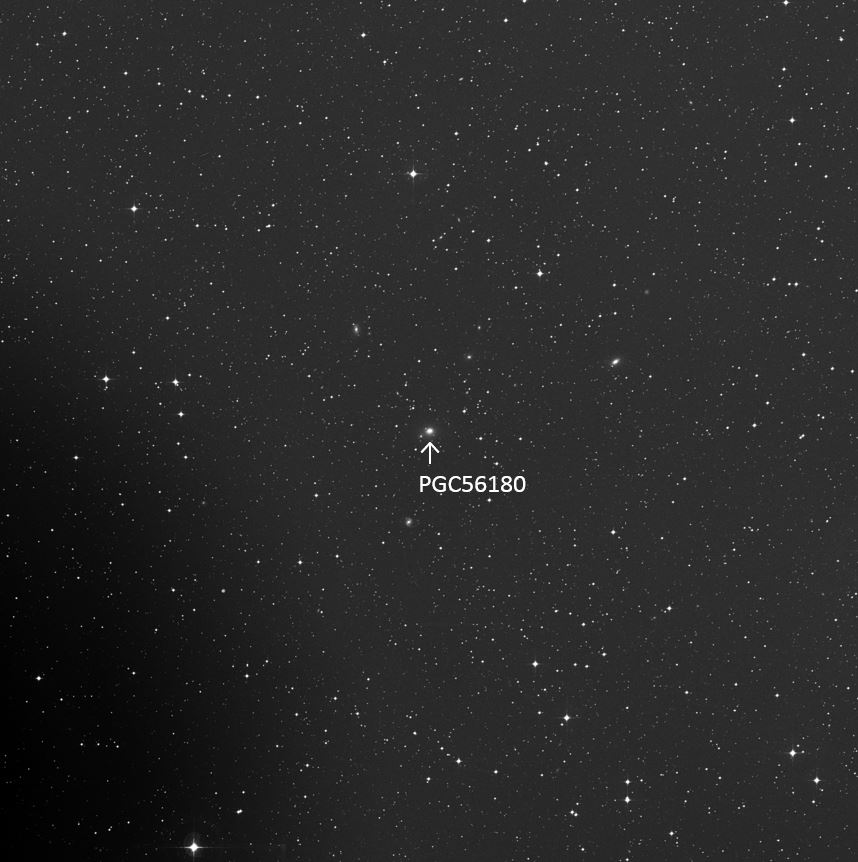
PGC56180. The image is 60’ wide.
The Digitized Sky Survey copyright © 1994
PGC56180, in the constellation of Libra, was the only DSO that was
non-globular cluster during the session. The magnitude is 14th and it
looked star-like image. I could manage to detect it as it was slightly
burred, though the apparent diameter is some 1’. I felt that I would
overlook it without highly concentrating on my heart on peering into the
FOV.
Coldness is the greatest at this time of the year when the constellation
of Scopus rises. Having said that, it was warm in comparison with that in
Niigata, even at the observing site where the altitude is 940 m a.s.l. The
air temperature was -3 degrees Celsius this predawn.
Top of this page












